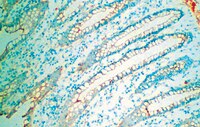Regulation of expression and role of leukemia inhibitory factor and interleukin-6 in the uterus of early pregnant pigs.
A Blitek,E Morawska,A J Ziecik
Theriogenology
78
2011
Mostrar resumen
Cytokines, which are generally involved in the process of inflammation, may also play a critical role in conceptus implantation. We examined: (1) the expression profiles of leukemia inhibitory factor (LIF) and interleukin (IL)-6 mRNA and their protein content in the endometrium of cyclic and pregnant gilts on Days 10 to 18 after estrus; (2) the effect of conceptus-exposed medium on LIF and IL-6 synthesis in the endometrium; (3) the profiles of IL6R and LIFR mRNA expression in pig conceptuses collected on Days 10 to 18 of pregnancy; and (4) the effect of LIF and IL-6 on the attachment and proliferation of porcine trophoblast cells. The expression of LIF mRNA in the endometrium increased between Days 10 and 12 in both cyclic and pregnant gilts, and tended to be higher in Day 12 pregnant animals compared with nonpregnant ones. The LIF protein content in the uterine lumen peaked on Day 12 of pregnancy, and was higher than on Day 12 of the estrous cycle. Endometrial IL-6 mRNA expression was upregulated on Day 12 in pregnant gilts compared with nonpregnant animals. Moreover, a higher content of IL-6 protein was observed in pregnant than in cyclic gilts. The addition of conceptus-exposed medium resulted in up-regulation of LIF and IL6 mRNA expression, and increased IL-6 content in endometrial slices. In conceptuses, increased mRNA expression was detected on Days 10 to 14 for IL6R and on Day 14 for LIFR, when compared with other days studied. LIF and IL-6 stimulated the attachment and proliferation of trophoblast cells in vitro. In summary, LIF and IL-6 are important components of embryo-uterine interactions during early pregnancy in the pig, and may contribute to successful conceptus implantation. | 22920593
 |
Interactions between galectin-3 and integrinbeta3 in regulating endometrial cell proliferation and adhesion.
Lei CX, Zhang W, Zhou JP, Liu YK
Human reproduction (Oxford, England)
24
2879-89
2009
Mostrar resumen
BACKGROUND: Galectin-3 (gal-3) is a beta-galactoside-binding protein which can be detected in endometrium. The study was designed to investigate synergism of gal-3 and integrinbeta3 in endometrial cell proliferation and adhesion in an in vitro model of endometrial receptivity. METHODS: The RL95-2 cell line was employed as an in vitro model for receptive endometrium. Cells transfected with gal-3 siRNA or treated with exogenous gal-3 were incubated with or without function-blocking integrinbeta1/3 antibody for evaluating synergism of gal-3 and integrins on cell proliferation and adhesion. Proliferation was measured by BrdU incorporation, and adhesion to fibronectin (FN) was determined by an adhesion assay. Integrin expression was analyzed by Flow Cytometry and western blots. Bewo spheroids were co-cultured with the RL95-2 monolayer to mimic the blastocyst-endometrial interaction, and colocalization of gal-3, integrinbeta3 and FN at the interface was observed by confocal microscopy. RESULTS: The knock-down of gal-3 inhibited RL95-2 cell proliferation and adhesion. However, a reduction of proliferation and adhesion was also observed in presence of exogenous gal-3, and this was further reduced by a functional block to integrinbeta3. Moreover, gal-3 knock-down significantly increased integrinbeta3 expression, however, the colocalization of integrinbeta3 and FN was not increased. As expected, the colocalization of integrinbeta3 was decreased with the knock-down of gal-3. CONCLUSIONS: This study has provided an in vitro model for the complex interactions between gal-3 and integrinbeta3 in the regulation of endometrial cell proliferation and adhesion. | 19633306
 |










